Grocers
The first occupant of 5 Moray Place was also the first of three grocers to live there; Gavin Wilson was resident between 1862 and 1865. He was a hamcurer & provision merchant, of Wilson, Ferguson & Co at 62 Little Street in Calton.
He was born in 1822, the second of five children, to William Wilson & Mary Cleland in Mauchline, Ayrshire. He moved to Glasgow in the 1840s and joined the grocery trade. His sister Janet married Hugh Slimmon in 1846 and Gavin moved in and boarded with them and their family for many years. Slimmon was himself a wholesale grocer at 48 Hutcheson Street.
Gavin moved to Moray Place in 1862 but moved out again in 1865 and was back with the Slimmon family in the 1871 census. The Slimmon family ended up at Duneaton Villa, 15 Albert Drive, Pollokshields, as did Gavin, and he died there in 1915 .
My research originally suggested he was unmarried, and didn’t like life alone in Moray Place, but the current owners (see comments) tell me the deeds record that the property was bought in the name of his wife, Annie Ferguson or Wilson, for £510. I can find no trace of Annie, but also no trace of a business partner called Ferguson either. He only briefly traded under that name before disappearing from the PO Directories around 1866; perhaps subsequently he just worked for the Slimmons. So I sense an intriguing tale, but can’t take it further at present.
From 1866 to 1881 the owner was John Ewing, another grocer and a wine merchant, of 221 Argyle Street. He was born at Fowlis Wester, Perthshire in 1820, and married Sarah McIntyre in 1850. She gave him two daughters, though one died aged 2, and she herself died in 1859. He then married again in 1861 to Ann Ewing of Fowlis Wester, perhaps a relative, and 24 years his younger. They had a further daughter, Mary Borland Ewing, who was probably born at Moray Place.
John had started as a handloom weaver before becoming a grocer. When he left Moray Place in 1881 he moved to Crieff, closer to home, and he retired there. He died in 1906 aged 87 .
Andrew Mudie
Next to move in was Andrew Mudie around 1881-2.
Andrew was born at St Monans, Fife, in 1839. He married Janet McLean in 1862 in Paisley and they had a son in 1869 and a daughter in 1872 .
Glasgow Athenaeum
Initially he worked as a shawl designer in Paisley, but by 1863 he was the superintendent of the Glasgow Athenaeum. The Athenaeum began life as the New Assembly and Concert Rooms on Ingram Street, designed by brothers Robert and James Adam, and built 1796-8. It was a focal point for the socialising merchant classes, with dances and concerts.
The Athenaeum was an educational society formed by young businessmen in the city to bridge the gap between the Glasgow Mechanics’ Institution and the University. It met at the Assembly Rooms from its foundation in 1847, when Charles Dickens was the chair at the opening ceremony. Thus the Assembly Rooms became the Athenaeum, and changed from a place of frivolity to learning .
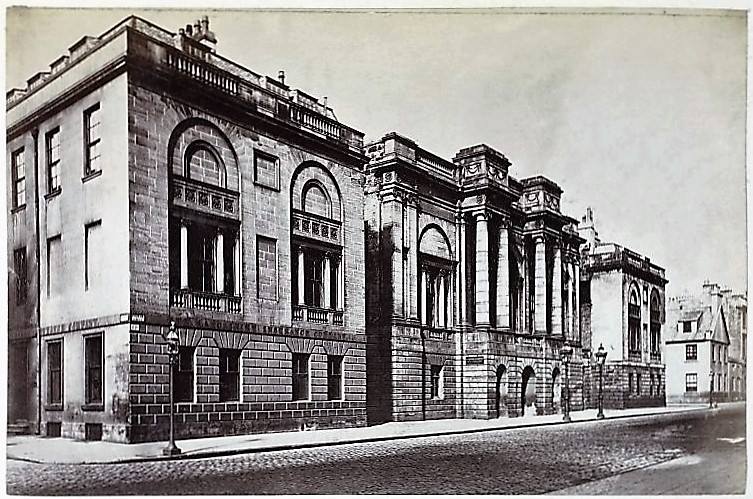
The Assembly Rooms, Ingram Street, with additional wings built 1807. Later known as the Athenaeum. Photo by Thomas Annan. Source: Canmore

Advert for the Athenaeum’s classes, Glasgow Courier 17 Sep 1863. Andrew Mudie is the Superintendent. Source: BNA
The Athenaeum building is of interest because it was demolished in 1892 to allow an expansion backwards of the General Post Office building on George Square, but Baillie James McLennan sought to preserve the large central window of the building. This became the McLennan Arch, a grand entrance to Glasgow Green, which after a couple of moves around the park perimeter, now stands at the entrance off Saltmarket.
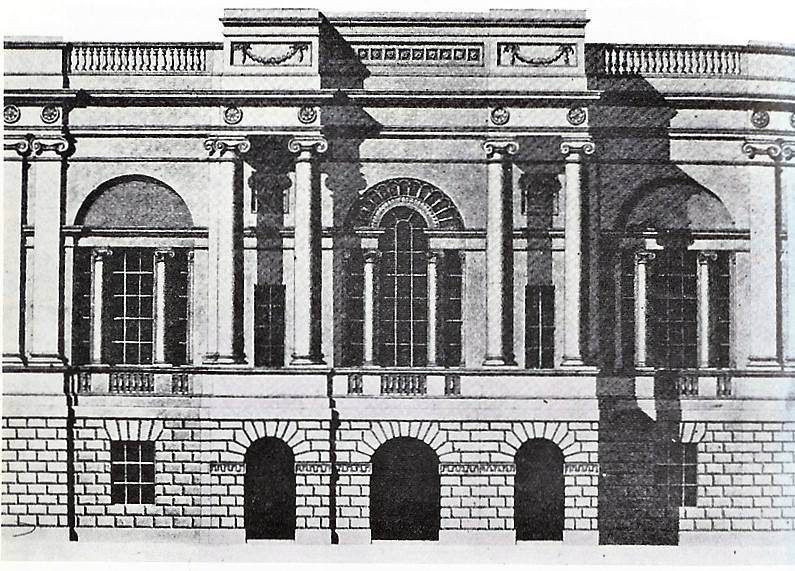
The Assembly Rooms, as built 1796-8. Note the large central window and columns. Source: Hidden Glasgow
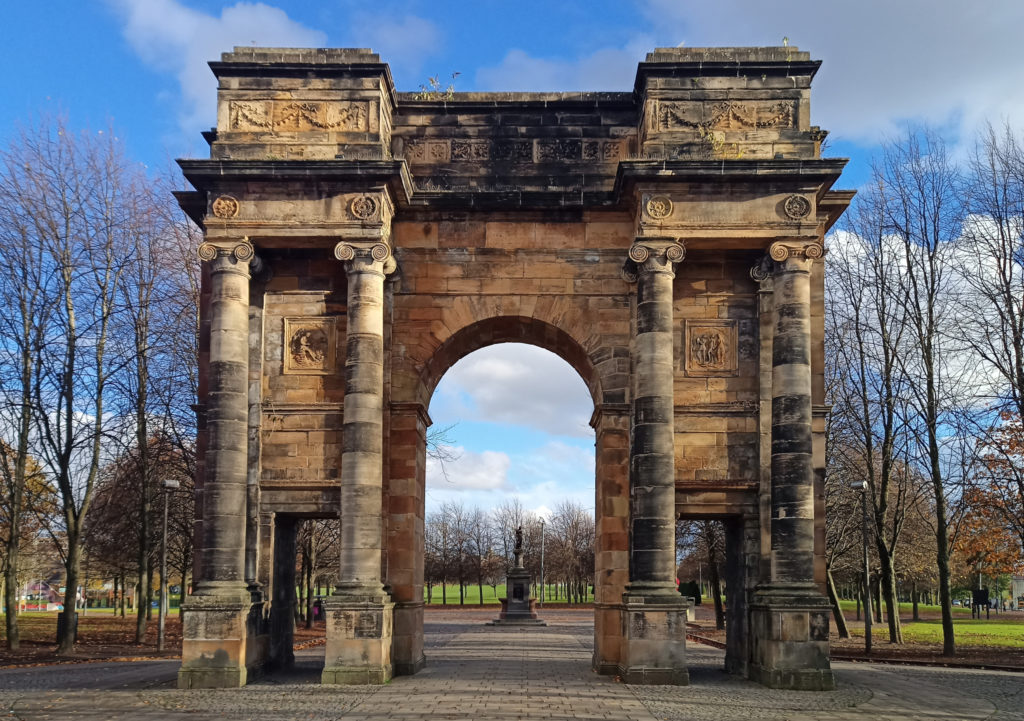
All that remains of the Glasgow Athenaeum. The same window and columns welcoming you to Glasgow Green as the McLennan Arch. Source: Author’s own
The Athenaeum itself moved to what is now Nelson Mandela Place, and was a forerunner of the Royal Conservatoire of Scotland.
Journalism
Mudie then moved into newspapers, taking up a post at the Citizen, where he spent nearly 40 years, rising to be editor of the Weekly Citizen, deputy editor of the Evening Citizen, a leader writer and a drama critic.
He became a Strathbungo resident; in 1871 he was living at Elcho Place on Pollokshaws Road, and in 1881 at Regents Park Terrace, just before he moved to Moray Place .

Mr Andrew Mudie of the Evening Citizen (R) and other journalists. Sketch of a press viewing of an exhibition to raise funds for a Peoples’ Palace, 1890. Source: Electric Scotland
In 1909 he warranted a biography in “Who’s Who in Glasgow 1909” .
THE editor of the Weekly Citizen, and assistant-editor of the Evening Citizen, is a native of Fife, and was born at St. Monance in 1839. He spent his youth in Paisley as a shawl designer, then removed to Glasgow, and for nearly three years was Secretary of Glasgow Athenaeum. From the Athenaeum he passed to the staff of the Citizen, where he gained an insight into newspaper work, indeed was taught the essentials of newspaper work by its editor and proprietor, the late Dr. James Hedderwick. As sub-editor and leader writer he has been identified with the Weekly and Evening Citizens for nearly forty years, and since the conversion of the proprietary into a limited liability company he has been one of the directors. He is a specialist on art and the drama, and was counted among the familiar and honoured friends of the late Sir Henry Irving.
A quiet, retiring man, Mr. Mudie has never obtruded himself on the public life of the city, but he has exercised a vital influence on Glasgow and the Scottish press. The Citizen was the earliest afternoon paper north of the Tweed.
Mr. Mudie is an omnivorous reader, with a singular and rapid power of judgment which enables him to seize upon and take the best out of everything. As evidence of this it is only necessary to cite the Weekly Citizen, which was not only the earliest of the literary extract papers, but for more than a generation has remained incomparably the best of its class.
In 1889 the Citizen moved to new offices at 24 St Vincent Place. While the paper folded in 1974, the name has been revived as The Citizen restaurant in the same building.

Postcard of The Evening Citizen offices at St Vincent Place c 1908. Source: TheGlasgowStory
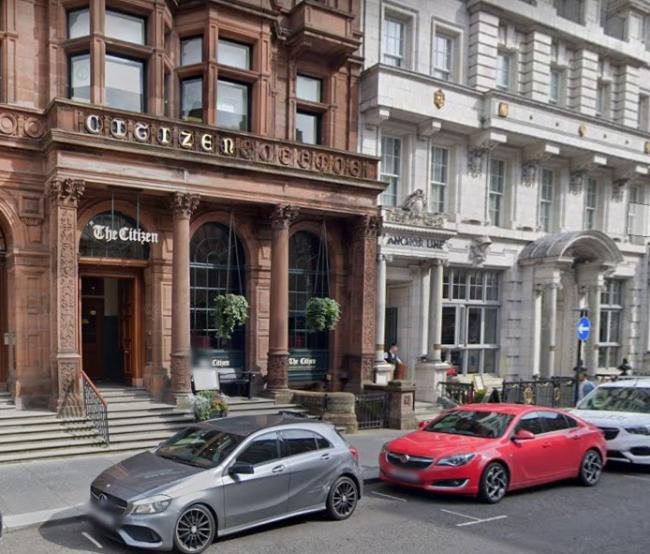
The Citizen Bar, St Vincent Place. Former offices of the Evening Citizen. Source: Evening Times
Andrew died at Moray Place on 5 Feb 1922. His wife predeceased him, passing away in November 1911.
The Mudie Children
Andrew’s children Robert and Janet were living at 5 Moray Place at the time of his death. They lived together at Moray Place until the early 1930s, moving first to Fotheringay Road, to Belhaven Terrace by 1938, and back to 17 Fotheringay Road in 1939. Janet died there in 1942, a spinster.
Robert was an iron merchant, and agent for Lones, Vernon, and Holden of Smethwick. They were big in railway axles apparently.
Later residents included John Young in 1939 and HB Kennedy in 1941, but the Post Office directories offer no clues to their identities.
That’s all I know of 5 Moray Place. Additions and corrections are welcome.
References
{3557955:5B4R6PK9},{3557955:IGYQFCAH};{3557955:5B4R6PK9},{3557955:IGYQFCAH};{3557955:IGYQFCAH};{3557955:VT5IT6YN},{3557955:M6VUA7P8},{3557955:MB2KYEMG};{3557955:5B4R6PK9};{3557955:MIGQGRUU}
vancouver
asc
0
3831
%7B%22status%22%3A%22success%22%2C%22updateneeded%22%3Afalse%2C%22instance%22%3A%22zotpress-6ddeacd658fe2bd8cf3acfc8562fd7ca%22%2C%22meta%22%3A%7B%22request_last%22%3A0%2C%22request_next%22%3A0%2C%22used_cache%22%3Atrue%7D%2C%22data%22%3A%5B%7B%22key%22%3A%22IGYQFCAH%22%2C%22library%22%3A%7B%22id%22%3A3557955%7D%2C%22meta%22%3A%7B%22numChildren%22%3A1%7D%2C%22bib%22%3A%22%3Cdiv%20class%3D%5C%22csl-bib-body%5C%22%20style%3D%5C%22line-height%3A%201.35%3B%20%5C%22%3E%5Cn%20%20%3Cdiv%20class%3D%5C%22csl-entry%5C%22%20style%3D%5C%22clear%3A%20left%3B%20%5C%22%3E%5Cn%20%20%20%20%3Cdiv%20class%3D%5C%22csl-left-margin%5C%22%20style%3D%5C%22float%3A%20left%3B%20padding-right%3A%200.5em%3B%20text-align%3A%20right%3B%20width%3A%201em%3B%5C%22%3E1.%3C%5C%2Fdiv%3E%3Cdiv%20class%3D%5C%22csl-right-inline%5C%22%20style%3D%5C%22margin%3A%200%20.4em%200%201.5em%3B%5C%22%3EGenealogy%2C%20Family%20Trees%20and%20Family%20History%20Records%20online%20-%20Ancestry.com%20%5BInternet%5D.%20%5Bcited%202022%20Nov%205%5D.%20Available%20from%3A%20%3Ca%20href%3D%27https%3A%5C%2F%5C%2Fwww.ancestry.co.uk%5C%2F%27%3Ehttps%3A%5C%2F%5C%2Fwww.ancestry.co.uk%5C%2F%3C%5C%2Fa%3E%3C%5C%2Fdiv%3E%5Cn%20%20%3C%5C%2Fdiv%3E%5Cn%3C%5C%2Fdiv%3E%22%2C%22data%22%3A%7B%22itemType%22%3A%22webpage%22%2C%22title%22%3A%22Genealogy%2C%20Family%20Trees%20and%20Family%20History%20Records%20online%20-%20Ancestry.com%22%2C%22creators%22%3A%5B%5D%2C%22abstractNote%22%3A%22%22%2C%22date%22%3A%22%22%2C%22url%22%3A%22https%3A%5C%2F%5C%2Fwww.ancestry.co.uk%5C%2F%22%2C%22language%22%3A%22%22%2C%22collections%22%3A%5B%22CAR6MXPM%22%5D%2C%22dateModified%22%3A%222022-11-05T14%3A51%3A42Z%22%7D%7D%2C%7B%22key%22%3A%225B4R6PK9%22%2C%22library%22%3A%7B%22id%22%3A3557955%7D%2C%22meta%22%3A%7B%22numChildren%22%3A0%7D%2C%22bib%22%3A%22%3Cdiv%20class%3D%5C%22csl-bib-body%5C%22%20style%3D%5C%22line-height%3A%201.35%3B%20%5C%22%3E%5Cn%20%20%3Cdiv%20class%3D%5C%22csl-entry%5C%22%20style%3D%5C%22clear%3A%20left%3B%20%5C%22%3E%5Cn%20%20%20%20%3Cdiv%20class%3D%5C%22csl-left-margin%5C%22%20style%3D%5C%22float%3A%20left%3B%20padding-right%3A%200.5em%3B%20text-align%3A%20right%3B%20width%3A%201em%3B%5C%22%3E1.%3C%5C%2Fdiv%3E%3Cdiv%20class%3D%5C%22csl-right-inline%5C%22%20style%3D%5C%22margin%3A%200%20.4em%200%201.5em%3B%5C%22%3EGlasgow%20Post%20Office%20Directories%20%5BInternet%5D.%20Available%20from%3A%20%3Ca%20href%3D%27https%3A%5C%2F%5C%2Fdigital.nls.uk%5C%2Fdirectories%5C%2Fbrowse%5C%2Farchive%5C%2F91168983%27%3Ehttps%3A%5C%2F%5C%2Fdigital.nls.uk%5C%2Fdirectories%5C%2Fbrowse%5C%2Farchive%5C%2F91168983%3C%5C%2Fa%3E%3C%5C%2Fdiv%3E%5Cn%20%20%3C%5C%2Fdiv%3E%5Cn%3C%5C%2Fdiv%3E%22%2C%22data%22%3A%7B%22itemType%22%3A%22document%22%2C%22title%22%3A%22Glasgow%20Post%20Office%20Directories%22%2C%22creators%22%3A%5B%5D%2C%22abstractNote%22%3A%22%22%2C%22date%22%3A%22%22%2C%22language%22%3A%22%22%2C%22url%22%3A%22https%3A%5C%2F%5C%2Fdigital.nls.uk%5C%2Fdirectories%5C%2Fbrowse%5C%2Farchive%5C%2F91168983%22%2C%22collections%22%3A%5B%22CAR6MXPM%22%5D%2C%22dateModified%22%3A%222022-11-05T14%3A50%3A13Z%22%7D%7D%2C%7B%22key%22%3A%22MIGQGRUU%22%2C%22library%22%3A%7B%22id%22%3A3557955%7D%2C%22meta%22%3A%7B%22numChildren%22%3A1%7D%2C%22bib%22%3A%22%3Cdiv%20class%3D%5C%22csl-bib-body%5C%22%20style%3D%5C%22line-height%3A%201.35%3B%20%5C%22%3E%5Cn%20%20%3Cdiv%20class%3D%5C%22csl-entry%5C%22%20style%3D%5C%22clear%3A%20left%3B%20%5C%22%3E%5Cn%20%20%20%20%3Cdiv%20class%3D%5C%22csl-left-margin%5C%22%20style%3D%5C%22float%3A%20left%3B%20padding-right%3A%200.5em%3B%20text-align%3A%20right%3B%20width%3A%201em%3B%5C%22%3E1.%3C%5C%2Fdiv%3E%3Cdiv%20class%3D%5C%22csl-right-inline%5C%22%20style%3D%5C%22margin%3A%200%20.4em%200%201.5em%3B%5C%22%3EWho%26%23x2019%3Bs%20Who%20in%20Glasgow%20in%201909%3A%20Andrew%20Mudie%20%5BInternet%5D.%20%5Bcited%202022%20Nov%201%5D.%20Available%20from%3A%20%3Ca%20href%3D%27http%3A%5C%2F%5C%2Fgdl.cdlr.strath.ac.uk%5C%2Feyrwho%5C%2Feyrwho1272.htm%27%3Ehttp%3A%5C%2F%5C%2Fgdl.cdlr.strath.ac.uk%5C%2Feyrwho%5C%2Feyrwho1272.htm%3C%5C%2Fa%3E%3C%5C%2Fdiv%3E%5Cn%20%20%3C%5C%2Fdiv%3E%5Cn%3C%5C%2Fdiv%3E%22%2C%22data%22%3A%7B%22itemType%22%3A%22webpage%22%2C%22title%22%3A%22Who%27s%20Who%20in%20Glasgow%20in%201909%3A%20Andrew%20Mudie%22%2C%22creators%22%3A%5B%5D%2C%22abstractNote%22%3A%22%22%2C%22date%22%3A%22%22%2C%22url%22%3A%22http%3A%5C%2F%5C%2Fgdl.cdlr.strath.ac.uk%5C%2Feyrwho%5C%2Feyrwho1272.htm%22%2C%22language%22%3A%22%22%2C%22collections%22%3A%5B%22CAR6MXPM%22%5D%2C%22dateModified%22%3A%222022-11-01T22%3A08%3A52Z%22%7D%7D%2C%7B%22key%22%3A%22MB2KYEMG%22%2C%22library%22%3A%7B%22id%22%3A3557955%7D%2C%22meta%22%3A%7B%22parsedDate%22%3A%222016-10-04%22%2C%22numChildren%22%3A1%7D%2C%22bib%22%3A%22%3Cdiv%20class%3D%5C%22csl-bib-body%5C%22%20style%3D%5C%22line-height%3A%201.35%3B%20%5C%22%3E%5Cn%20%20%3Cdiv%20class%3D%5C%22csl-entry%5C%22%20style%3D%5C%22clear%3A%20left%3B%20%5C%22%3E%5Cn%20%20%20%20%3Cdiv%20class%3D%5C%22csl-left-margin%5C%22%20style%3D%5C%22float%3A%20left%3B%20padding-right%3A%200.5em%3B%20text-align%3A%20right%3B%20width%3A%201em%3B%5C%22%3E1.%3C%5C%2Fdiv%3E%3Cdiv%20class%3D%5C%22csl-right-inline%5C%22%20style%3D%5C%22margin%3A%200%20.4em%200%201.5em%3B%5C%22%3ELost%20Glasgow.%20The%20McLennan%20Arch%20-%20Lost%20Glasgow%20on%20Facebook%20%5BInternet%5D.%202016%20%5Bcited%202022%20Nov%201%5D.%20Available%20from%3A%20%3Ca%20href%3D%27https%3A%5C%2F%5C%2Fwww.facebook.com%5C%2Flostglasgowofficial%5C%2Fposts%5C%2Fpfbid0jfx6ZkEVKwvdQT2ekkTvi9VhFUirc5mMFtwuG5n6iDRMbsLTHk5HXEBcZVep2LAGl%27%3Ehttps%3A%5C%2F%5C%2Fwww.facebook.com%5C%2Flostglasgowofficial%5C%2Fposts%5C%2Fpfbid0jfx6ZkEVKwvdQT2ekkTvi9VhFUirc5mMFtwuG5n6iDRMbsLTHk5HXEBcZVep2LAGl%3C%5C%2Fa%3E%3C%5C%2Fdiv%3E%5Cn%20%20%3C%5C%2Fdiv%3E%5Cn%3C%5C%2Fdiv%3E%22%2C%22data%22%3A%7B%22itemType%22%3A%22webpage%22%2C%22title%22%3A%22The%20McLennan%20Arch%20-%20Lost%20Glasgow%20on%20Facebook%22%2C%22creators%22%3A%5B%7B%22creatorType%22%3A%22author%22%2C%22firstName%22%3A%22Lost%20Glasgow%22%2C%22lastName%22%3A%22%22%7D%5D%2C%22abstractNote%22%3A%22%22%2C%22date%22%3A%224%20Oct%202016%22%2C%22url%22%3A%22https%3A%5C%2F%5C%2Fwww.facebook.com%5C%2Flostglasgowofficial%5C%2Fposts%5C%2Fpfbid0jfx6ZkEVKwvdQT2ekkTvi9VhFUirc5mMFtwuG5n6iDRMbsLTHk5HXEBcZVep2LAGl%22%2C%22language%22%3A%22%22%2C%22collections%22%3A%5B%22CAR6MXPM%22%5D%2C%22dateModified%22%3A%222022-11-01T22%3A02%3A55Z%22%7D%7D%2C%7B%22key%22%3A%22M6VUA7P8%22%2C%22library%22%3A%7B%22id%22%3A3557955%7D%2C%22meta%22%3A%7B%22numChildren%22%3A1%7D%2C%22bib%22%3A%22%3Cdiv%20class%3D%5C%22csl-bib-body%5C%22%20style%3D%5C%22line-height%3A%201.35%3B%20%5C%22%3E%5Cn%20%20%3Cdiv%20class%3D%5C%22csl-entry%5C%22%20style%3D%5C%22clear%3A%20left%3B%20%5C%22%3E%5Cn%20%20%20%20%3Cdiv%20class%3D%5C%22csl-left-margin%5C%22%20style%3D%5C%22float%3A%20left%3B%20padding-right%3A%200.5em%3B%20text-align%3A%20right%3B%20width%3A%201em%3B%5C%22%3E1.%3C%5C%2Fdiv%3E%3Cdiv%20class%3D%5C%22csl-right-inline%5C%22%20style%3D%5C%22margin%3A%200%20.4em%200%201.5em%3B%5C%22%3ETheGlasgowStory%3A%20Athenaeum%20opening%20%5BInternet%5D.%20%5Bcited%202022%20Nov%201%5D.%20Available%20from%3A%20%3Ca%20href%3D%27https%3A%5C%2F%5C%2Fwww.theglasgowstory.com%5C%2Fimage%5C%2F%3Finum%3DTGSA01169%26t%3D2%27%3Ehttps%3A%5C%2F%5C%2Fwww.theglasgowstory.com%5C%2Fimage%5C%2F%3Finum%3DTGSA01169%26t%3D2%3C%5C%2Fa%3E%3C%5C%2Fdiv%3E%5Cn%20%20%3C%5C%2Fdiv%3E%5Cn%3C%5C%2Fdiv%3E%22%2C%22data%22%3A%7B%22itemType%22%3A%22webpage%22%2C%22title%22%3A%22TheGlasgowStory%3A%20Athenaeum%20opening%22%2C%22creators%22%3A%5B%5D%2C%22abstractNote%22%3A%22%22%2C%22date%22%3A%22%22%2C%22url%22%3A%22https%3A%5C%2F%5C%2Fwww.theglasgowstory.com%5C%2Fimage%5C%2F%3Finum%3DTGSA01169%26t%3D2%22%2C%22language%22%3A%22%22%2C%22collections%22%3A%5B%22CAR6MXPM%22%5D%2C%22dateModified%22%3A%222022-11-01T22%3A01%3A39Z%22%7D%7D%2C%7B%22key%22%3A%22VT5IT6YN%22%2C%22library%22%3A%7B%22id%22%3A3557955%7D%2C%22meta%22%3A%7B%22numChildren%22%3A1%7D%2C%22bib%22%3A%22%3Cdiv%20class%3D%5C%22csl-bib-body%5C%22%20style%3D%5C%22line-height%3A%201.35%3B%20%5C%22%3E%5Cn%20%20%3Cdiv%20class%3D%5C%22csl-entry%5C%22%20style%3D%5C%22clear%3A%20left%3B%20%5C%22%3E%5Cn%20%20%20%20%3Cdiv%20class%3D%5C%22csl-left-margin%5C%22%20style%3D%5C%22float%3A%20left%3B%20padding-right%3A%200.5em%3B%20text-align%3A%20right%3B%20width%3A%201em%3B%5C%22%3E1.%3C%5C%2Fdiv%3E%3Cdiv%20class%3D%5C%22csl-right-inline%5C%22%20style%3D%5C%22margin%3A%200%20.4em%200%201.5em%3B%5C%22%3ETheGlasgowStory%3A%20New%20Assembly%20Rooms%20%5BInternet%5D.%20%5Bcited%202022%20Nov%201%5D.%20Available%20from%3A%20%3Ca%20href%3D%27https%3A%5C%2F%5C%2Fwww.theglasgowstory.com%5C%2Fimage%5C%2F%3Finum%3DTGSA01084%26t%3D2%27%3Ehttps%3A%5C%2F%5C%2Fwww.theglasgowstory.com%5C%2Fimage%5C%2F%3Finum%3DTGSA01084%26t%3D2%3C%5C%2Fa%3E%3C%5C%2Fdiv%3E%5Cn%20%20%3C%5C%2Fdiv%3E%5Cn%3C%5C%2Fdiv%3E%22%2C%22data%22%3A%7B%22itemType%22%3A%22webpage%22%2C%22title%22%3A%22TheGlasgowStory%3A%20New%20Assembly%20Rooms%22%2C%22creators%22%3A%5B%5D%2C%22abstractNote%22%3A%22%22%2C%22date%22%3A%22%22%2C%22url%22%3A%22https%3A%5C%2F%5C%2Fwww.theglasgowstory.com%5C%2Fimage%5C%2F%3Finum%3DTGSA01084%26t%3D2%22%2C%22language%22%3A%22%22%2C%22collections%22%3A%5B%22CAR6MXPM%22%5D%2C%22dateModified%22%3A%222022-11-01T22%3A01%3A31Z%22%7D%7D%5D%7D
1.
Genealogy, Family Trees and Family History Records online - Ancestry.com [Internet]. [cited 2022 Nov 5]. Available from:
https://www.ancestry.co.uk/
Like this:
Like Loading...






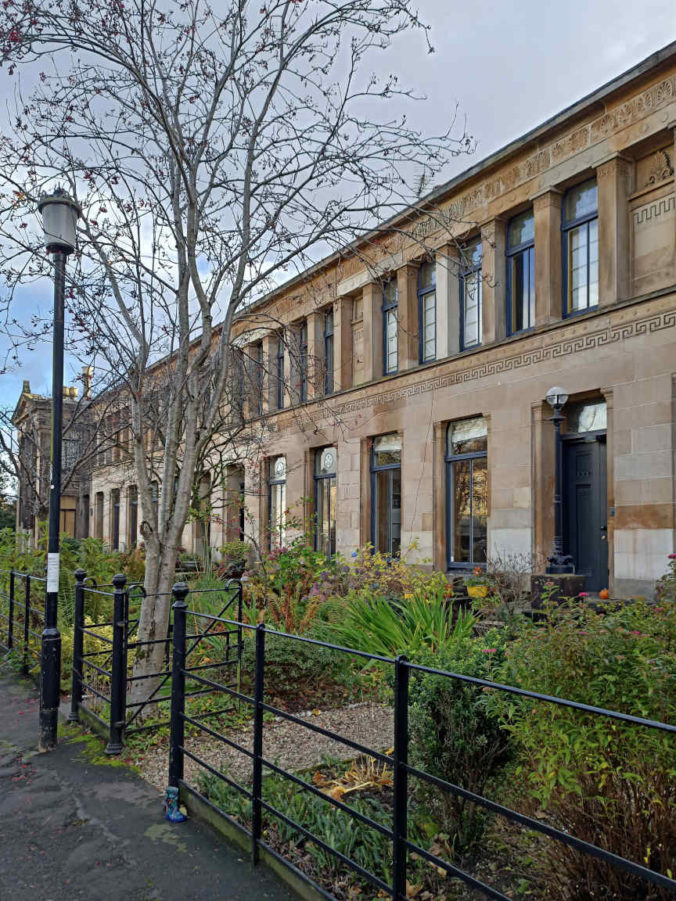


November 11, 2022 at 10:23 pm
Andrew Mudie’s story is interesting. Hard to imagine that a person could lead such a varied working life today and be a prominent figure in his occupations. Apparently not a grand stander which I would have thought unusual in the media then and now.
Thanks again Andrew for such an enjoyable read
November 15, 2022 at 5:02 pm
The Borland’s are a well known weaving family from Kilbarchan.
November 15, 2022 at 7:11 pm
Mary Borland Ewing’s grandmother was a Borland, but from Perthshire I suspect. There are other Borlands in Strathbungo mind – Robert Borland from Stewarton lived at No 7 Moray Place, and was a shirtmaker.
See 7 Moray Place.
December 31, 2022 at 12:16 am
Hi there, thanks for the informative article. Our friends at 14 Moray Place brought it to our attention.
We are the current owners/keepers of the leaky, draughty, but charming ongoing restoration project that is No. 5 (begun 2017 and still going…)
Really interesting to read more about Andrew Mudie’s story. When we moved in we were given an envelope of old deeds and documents relating to the house. Mudie’s name is in there and I did enough trawling through the Post Office directory, etc to get some basic details on his life and work, but this piece has really fleshed things out, thanks.
As regards Gavin Wilson, we can gladly refute the suggestion that he was a lonely soul who never married. He was also possibly a progressive man (or a tax avoider…) as the house was bought in his wife’s name! We have the original 1860 Feu Disposition from Sir John Maxwell of Pollock to John McIntyre and William Stevenson, the builders of the terrace as designed by Alexander Thomson, and then the 10th July 1861 Feu Contract between McIntyre & Stevenson and an “Annie Ferguson or Wilson” – referred to as “Wife of Gavin Wilson, Provision Merchant, Stockwell Street, Glasgow”.
As women could not independently own property in those patriarchal times, the contract is written “with consent of her said husband for all right and interest he may have in the premises”. The sale price was £510 (in today’s money that’s just £48,139 – illustrates nicely how inflated house prices are!) The contract is 8 pages long and written in dense legal copperplate. Happy to share a photocopy if you have the desire to translate it.
The contract is signed first by her and second by him, I note that his provisioning company was “Wilson, Ferguson & Co” so perhaps his wife and/or father-in-law were his business partners. I must track down their marriage certificate. I wonder what happened to their marriage, perhaps she died, or she flung him oot of HER hoose and he move in with his pal?!
Some detective work needed.
Also interested to read that he was from Mauchline, I’m from that part of the world and have Wilson ancestry so he’s probably a relation…
Sadly we don’t have the whole history of the house and we too struggled to fill in the early 20th Century gap between Andrew Mudie and subsequent owners.
The next Disposition document we have is from 21st August 1959 when the house is sold to a “Mr Samuel Boobis, Factory Manager, sometime residing at 22 Prestwick Road, Newton-on-Ayr.”
I am a doctor and I know of a Professor Boobis, who is a Pharmacologist in London and a Glasgow University graduate. It is an uncommon surname so perhaps he is Samuel’s son?
The vendor to Samuel Boobis appears to have been three women, who held (or inherited?) a mortgage with the Dunfermline building society in August 1955:
“Mrs Anna Susanna Schrader or Gallacher residing formerly at 338 Kilmarnock Road… and then at 5 Moray Place with the consent and concurrence of Miss Janey Fraser and Mrs Maysie Mackay Martin or Fraser or McLaren both residing at 153 Glencroft Road, Croftfoot, Glasgow S4”
The latter two women also seem to have lived at Moray Place previously, because the disposition continues: “Further considering that… said… Miss Janey Fraser (now Mrs Janey Fraser or Jack) and Mrs Maysie Mackay Martin or Fraser or McLaren both sometime residing at 5 Moray Place, Strathbungo aforesaid and now at two Seabank Road, Prestwick…”
Reading between the lines, I presume they were sisters/cousins who inherited the house from a relative.
The house was sold again in 1977, 1983, 1990 and 2009. I have the complete ownership history subsequent to Samuel Boobis but I will defer from publishing it here for privacy reasons as I believe the 4 former owners are still alive.
Best wishes.